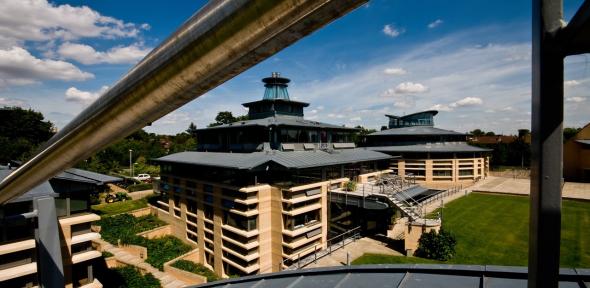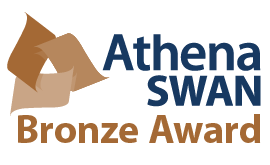
Every year 30 outstanding researchers whose work has already attracted international recognition and whose future career is exceptionally promising are awarded Philip Leverhulme Prizes. The prizes are each worth £100,000 which can be used over two or three years to advance the winners' research, and are awarded for different subject areas each year. In 2017 three of the five winners in mathematics and statistics were from the Mathematics Faculty at the University of Cambridge.
From finite to infinite
Dr Anders Hansen, from the Department of Applied Mathematics and Theoretical Physics (DAMTP), was recognised for his work on solving very hard problems and opening new directions in areas of great impact in applied analysis. One of Hansen's notable achievements is developing the solvability complexity index. Understanding complexity is one of the foundations of computational mathematics. But because the classical concept of complexity assumes a finite input, there are many real problems from science that can't be characterised with these classical classes. "These are much, much harder. But ironically, we compute with them on a daily basis." The solvability complexity index is a tool to understanding such problems.
Moving from the finite to the infinite also characterises another area of Hansen's work that was recognised by the Leverhulme Prize. Compressed sensing, developed in the mid 2000s, "turned lots of fields upside down, especially medical imaging." The initial theory of compressed sensing was based on a discrete set up: a finite matrix of sensor measurements, and a finite problem to solve. "Again the issue with the sciences is that many of these problems are truly infinite-dimensional." Hansen wanted to have a theory for how this compressed sensing would work in the infinite setting and worked with his colleague Ben Adcock to develop a theory for the infinite dimensional case.
You can read more about Hansen's work here.
Combining traditional approaches with machine learning
Professor Carola-Bibiane Schönlieb, Director of the Cantab Capital Institute for the Mathematics of Information, in DAMTP, has been recognised for her work on the foundations of image analysis. Her citation states that "her research is of fundamental mathematical significance as well as hugely relevant to the technology driving the current data revolution." She has been recognised for her work on mathematical imaging, in particular for combining the traditional model-based approach of image analysis with machine learning. As well as the Leverhulme Prize, she has recently been invited to write a paper for Acta Numerica on machine learning and inverse problems, one of the journals with the highest research impact in mathematics.
As well as the mathematical impact, Schönlieb's work has also has applications within cancer research and biomedical imaging, the reconstruction of paintings and frescoes, fingerprint enhancement and simulation, and feature reconstruction from aerial photography. "Why I'm so excited about the data driven component of my work is because of the collaboration with people in different disciplines," says Schönlieb. "You realise there's so much domain-specific expertise in these different disciplines that is almost impossible to capture with an [explicit] mathematical model. This is a big motivation for doing something data driven."
You can read more about Schönlieb’s work here.
A new tool for understanding moduli spaces
Dr Oscar Randal-Williams, from the Department of Pure Mathematics and Mathematics Statistics (DPMMS), has established himself as a clear leader in the field of algebraic topology - the area of maths that uses algebra to investigate geometry and topology. "Winning the prize is a great honour - if you look at the list of previous winners, many of whom have come from this department, you are somewhat awed," he says.
Randal-Williams works on moduli spaces - where rather than considering one mathematical object at a time, you instead consider the space of all such mathematical objects. He has been working with his colleagues Soren Galatius and Alexander Kupers on a new tool that could shed new light on certain types of moduli spaces. Their work makes use of an extra structure (called an E2-structure) that has long been known but has never before been used in this way. This simplest example of this structure comes from considering the space of points on a flat plane, but the structure arises in many different moduli spaces mathematicians are interested in. Randal-Williams has explored what other settings gives rise to moduli spaces with the same structure, and developed new ways for using this common structure.
"This is a new tool that can be used in different settings within pure mathematics." The work is still in progress, and he,Galatius and Kupers have written a foundational document which will allow researchers from different areas to use the new tool to explore this connection.
You can read more about Randal-Williams' work here.
The recipe for great research
For all three winners, being part of the Mathematics Faculty has contributed greatly to their research. "One instrumental component of being here in DAMTP was to be exposed to such a breadth and wealth of research that is happening in our department," says Schönlieb. The problems this stimulated for her group to work on came both from people within, but also outside of DAMTP. "I have so many interdisciplinary collaborations with people at Cambridge, a lot of the research I'm doing is very much driven by real problems."
Hansen also notes the value of colleagues, both within the faculty and in other disciplines. "I couldn't do it without the people in my group - it's been a great inspiration to have students and postdocs. We have fantastic students here." Alongside this has been the security and the freedom the maths faculty has given him. "The complete freedom has allowed me to go for high-risk and high-gain projects."
Randal-Williams also agrees this freedom has been of great benefit: "My work is not obviously applicable, it's not even mainstream in pure maths yet. But the department understands the value and recognises the importance of novel work."
The prize provides these researchers with extra resources to continue their work, which Hansen and Randal-Williams plan to use to hire more people to work on their projects. "It's a great incentive to continue," Hansen says. For Randal-Williams the Leverhulme Prize not only rewards work that has already been done: "I think, in a sense, these prizes are awarded for work that's yet to come."

